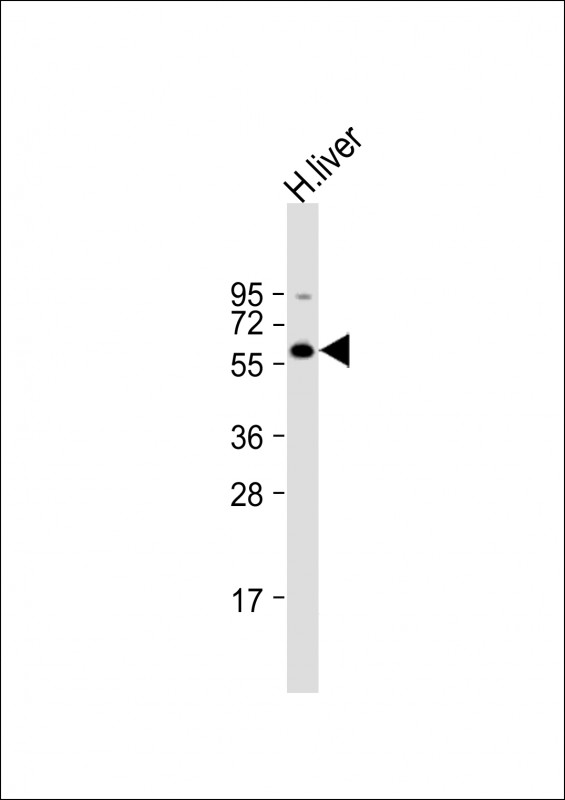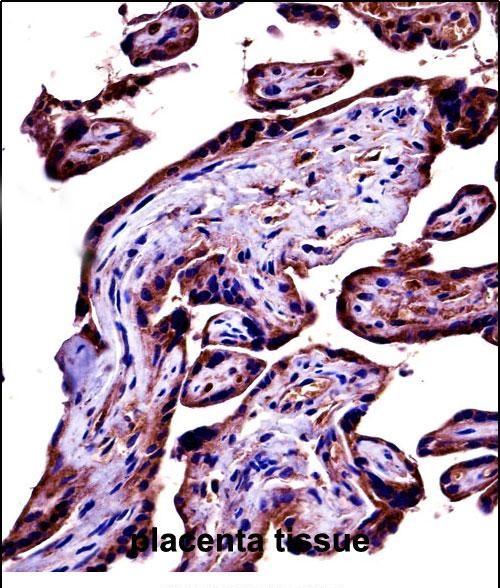C9 Antibody (Center)
Affinity Purified Rabbit Polyclonal Antibody (Pab)
- 产品详情
- 实验流程
- 背景知识
Application
| WB, IHC-P, E |
|---|---|
| Primary Accession | P02748 |
| Other Accession | NP_001728.1 |
| Reactivity | Human |
| Host | Rabbit |
| Clonality | Polyclonal |
| Isotype | Rabbit IgG |
| Calculated MW | 63173 Da |
| Antigen Region | 191-220 aa |
| Gene ID | 735 |
|---|---|
| Other Names | Complement component C9, Complement component C9a, Complement component C9b, C9 |
| Target/Specificity | This C9 antibody is generated from rabbits immunized with a KLH conjugated synthetic peptide between 191-220 amino acids from the Central region of human C9. |
| Dilution | WB~~1:1000 IHC-P~~1:100~500 E~~Use at an assay dependent concentration. |
| Format | Purified polyclonal antibody supplied in PBS with 0.09% (W/V) sodium azide. This antibody is purified through a protein A column, followed by peptide affinity purification. |
| Storage | Maintain refrigerated at 2-8°C for up to 2 weeks. For long term storage store at -20°C in small aliquots to prevent freeze-thaw cycles. |
| Precautions | C9 Antibody (Center) is for research use only and not for use in diagnostic or therapeutic procedures. |
| Name | C9 {ECO:0000303|PubMed:4018030, ECO:0000312|HGNC:HGNC:1358} |
|---|---|
| Function | Pore-forming component of the membrane attack complex (MAC), a multiprotein complex activated by the complement cascade, which inserts into a target cell membrane and forms a pore, leading to target cell membrane rupture and cell lysis (PubMed:22832194, PubMed:26841837, PubMed:26841934, PubMed:27052168, PubMed:30552328, PubMed:6177822, PubMed:9212048, PubMed:9634479). The MAC is initiated by proteolytic cleavage of C5 into complement C5b in response to the classical, alternative, lectin and GZMK complement pathways (PubMed:9212048, PubMed:9634479). The complement pathways consist in a cascade of proteins that leads to phagocytosis and breakdown of pathogens and signaling that strengthens the adaptive immune system (PubMed:9212048, PubMed:9634479). Constitutes the pore-forming subunit of the MAC complex: during MAC assembly, C9 associates with the C5b8 intermediate complex, and polymerizes to complete the pore (PubMed:26841934, PubMed:30111885, PubMed:30552328, PubMed:34752492, PubMed:4055801, PubMed:6177822). |
| Cellular Location | Secreted. Target cell membrane; Multi-pass membrane protein. Note=Secreted as soluble monomer (PubMed:26841934, PubMed:30111885, PubMed:4055801, PubMed:9634479) Oligomerizes at target membranes, forming a pre-pore (PubMed:26841934, PubMed:30111885, PubMed:31061395, PubMed:4055801, PubMed:9634479). A conformation change then leads to the formation of a 100 Angstrom diameter pore (PubMed:26841934, PubMed:30111885, PubMed:31061395, PubMed:4055801, PubMed:9634479). |
| Tissue Location | Plasma (at protein level). |
For Research Use Only. Not For Use In Diagnostic Procedures.
Provided below are standard protocols that you may find useful for product applications.
BACKGROUND
This gene encodes the final component of the complement system. It participates in the formation of the Membrane Attack Complex (MAC). The MAC assembles on bacterial membranes to form a pore, permitting disruption of bacterial membrane organization. Mutations in this gene cause component C9 deficiency. [provided by RefSeq].
REFERENCES
Bailey, S.D., et al. Diabetes Care 33(10):2250-2253(2010)
Han, S., et al. Hum. Immunol. 71(7):727-730(2010)
Rajaraman, P., et al. Cancer Epidemiol. Biomarkers Prev. 19(5):1356-1361(2010)
Bunkenborg, J., et al. Proteomics 4(2):454-465(2004)
Hofsteenge, J., et al. J. Biol. Chem. 274(46):32786-32794(1999)
终于等到您。ABCEPTA(百远生物)抗体产品。
点击下方“我要评价 ”按钮提交您的反馈信息,您的反馈和评价是我们最宝贵的财富之一,
我们将在1-3个工作日内处理您的反馈信息。
如有疑问,联系:0512-88856768 tech-china@abcepta.com.























 癌症的基本特征包括细胞增殖、血管生成、迁移、凋亡逃避机制和细胞永生等。找到癌症发生过程中这些通路的关键标记物和对应的抗体用于检测至关重要。
癌症的基本特征包括细胞增殖、血管生成、迁移、凋亡逃避机制和细胞永生等。找到癌症发生过程中这些通路的关键标记物和对应的抗体用于检测至关重要。 为您推荐一个泛素化位点预测神器——泛素化分析工具,可以为您的蛋白的泛素化位点作出预测和评分。
为您推荐一个泛素化位点预测神器——泛素化分析工具,可以为您的蛋白的泛素化位点作出预测和评分。 细胞自噬受体图形绘图工具为你的蛋白的细胞受体结合位点作出预测和评分,识别结合到自噬通路中的蛋白是非常重要的,便于让我们理解自噬在正常生理、病理过程中的作用,如发育、细胞分化、神经退化性疾病、压力条件下、感染和癌症。
细胞自噬受体图形绘图工具为你的蛋白的细胞受体结合位点作出预测和评分,识别结合到自噬通路中的蛋白是非常重要的,便于让我们理解自噬在正常生理、病理过程中的作用,如发育、细胞分化、神经退化性疾病、压力条件下、感染和癌症。








